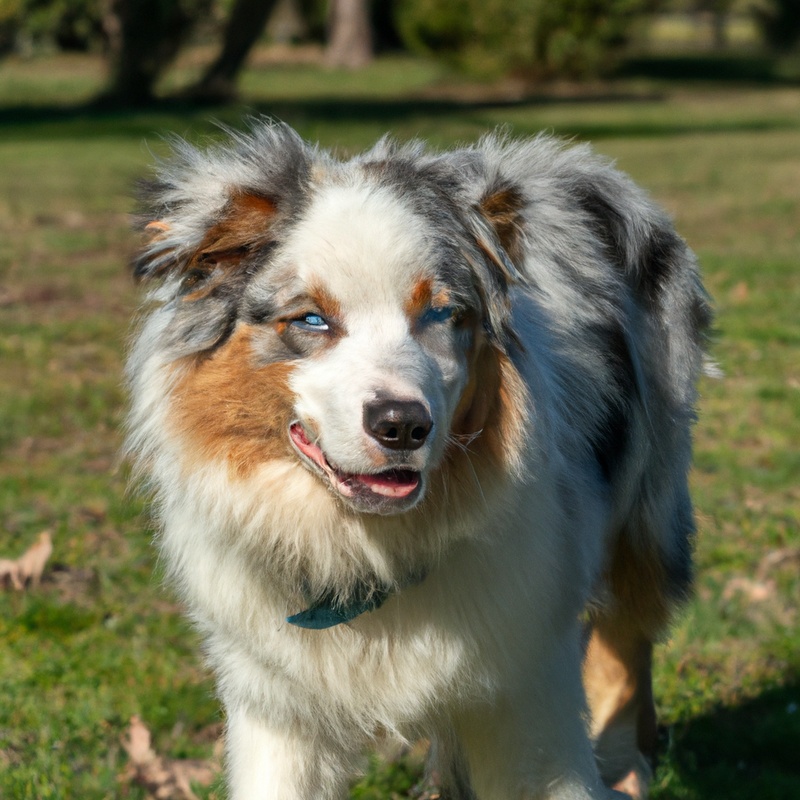Can Australian Shepherds Be Trained To Be Good With Cats?
Key Takeaways:
- Australian Shepherds can be trained to coexist peacefully with cats.
- Early socialization and gradual introductions are key to successful cat-dog integration.
- Consistent training and positive reinforcement can help Australian Shepherds develop good behaviors around cats.
- Supervision and managing interactions between Australian Shepherds and cats is crucial for their safety and wellbeing.
Imagine a household where cats and dogs coexist in harmony, curling up together by the fireplace. It sounds like a dream, right?
But what about Australian Shepherds?
These energetic and intelligent pups are known for their herding instincts, which may raise concerns about their compatibility with cats. As an expert dog trainer with years of experience, I can assure you that with the right approach, Australian Shepherds can absolutely learn to be good with cats.
In this blog, we will explore the dynamics between these two animals and delve into effective training techniques to foster a peaceful coexistence.
So, let’s jump right in and discover the secrets to creating a cat-friendly Australian Shepherd!
| Australian Shepherds and Cats | Yes | No |
|---|---|---|
| Trainability | ✓ | – |
| Socialization | ✓ | – |
| Past Experiences | ✓ | – |
| Breed Characteristics | ✓ | – |
Understanding the Australian Shepherd Breed
Overview of Australian Shepherds
Australian Shepherds are a popular dog breed known for their intelligence, agility, and herding abilities. They are medium-sized dogs with a well-muscled body and a thick double coat.
These dogs are highly energetic and require plenty of exercise and mental stimulation.
They excel in various dog sports and activities, such as obedience, agility, and herding trials. Australian Shepherds are loyal, affectionate, and make great companions.
They are known for their strong bond with their owners and can be protective of their family.
However, owners should be aware that Australian Shepherds can have a strong herding instinct, which may lead to chasing or nipping behaviors towards small animals, including cats. Proper training, socialization, and supervision are crucial when introducing Australian Shepherds to cats or any other small pets.
With the right approach and patience, it is possible for Australian Shepherds to coexist peacefully with cats in the same household.

Australian Shepherds’ Characteristics and Traits
Australian Shepherds have several distinct characteristics and traits that make them a unique breed. Here are some key features to consider:
- High Energy: Australian Shepherds are known for their boundless energy. They are an active breed that requires regular exercise and mental stimulation to stay happy and healthy.
- Intelligence: These dogs are highly intelligent and eager to please, which makes them quick learners. They excel in training and can easily pick up commands and tricks.
- Herding Instinct: Australian Shepherds were originally bred as herding dogs, and their instinct to gather and control animals is still strong. They may try to herd smaller animals, including cats, if not properly trained and socialized.
- Protective Nature: Australian Shepherds are known for their loyalty and protective instincts. They often form strong bonds with their families and can be vigilant in guarding them and their territory.
- Affectionate and Social: Despite their working dog origins, Australian Shepherds are also very affectionate and social. They enjoy spending time with their families and can be excellent companions.
- Vocal: Australian Shepherds have a tendency to be vocal and may bark or howl to communicate. This trait can vary from dog to dog, but it’s important to be aware that they may express themselves through vocalization.
When considering bringing an Australian Shepherd into a household with cats, it’s important to keep these characteristics in mind. With proper training, socialization, and patience, Australian Shepherds can learn to live harmoniously with cats.
Australian Shepherds and Their Natural Herding Instinct
Australian Shepherds have a strong natural herding instinct. This instinct comes from their history of being bred as working dogs on farms.
They have an innate drive to control the movement of animals, which can extend to cats and other pets in their household.
It’s important to understand this instinct and how it may affect their behavior around cats. By keeping their herding instincts in mind, we can better manage their interactions with cats and create a harmonious environment for both pets.
Introducing Cats to Australian Shepherds
Initial Preparation and Introduction
When introducing cats to Australian Shepherds, it’s important to start with some initial preparation and a controlled introduction process. Before bringing a cat home, make sure your Australian Shepherd is trained and has a solid understanding of basic commands.
Create a separate space for the cat with a gate or door to ensure a safe introduction.
Allow them to sniff each other’s scents first before any face-to-face interaction. Slowly introduce them in a supervised and controlled environment, rewarding positive behavior.
Be patient and monitor their interactions closely to ensure a successful introduction.

Slow and Controlled Introduction Process
When introducing Australian Shepherds to cats, it’s crucial to take a slow and controlled approach. Rushing the process can lead to stress and potential conflicts.
Start by keeping the animals in separate spaces and gradually introduce their scents through scent swapping.
Then, allow them to see and smell each other through a baby gate or a cracked door. Supervise their initial interactions closely and reward positive behavior.
Gradually increase their time together and always prioritize safety.
Patience and a gradual approach are key to a successful introduction.

Importance of Supervision and Patience
Supervision and patience are essential when introducing cats to Australian Shepherds. It’s important to closely monitor their interactions to ensure the safety and well-being of both animals.
By supervising their interactions, you can step in if any signs of aggression or stress arise.
Additionally, patience is key during the introduction process, as it may take time for the cat and dog to adjust to each other’s presence. Rushing the process can lead to negative outcomes, so take it slow and allow them to gradually become comfortable with one another.
Training Australian Shepherds to Get Along with Cats
Positive Reinforcement Training Techniques
Positive reinforcement training techniques are a highly effective way to train Australian Shepherds to get along with cats. This approach focuses on rewarding desirable behaviors and ignoring or redirecting undesirable behaviors.
Here are some key techniques you can use:
- Reward-based training: Use treats, praise, and toys as rewards for your Australian Shepherd when they exhibit calm and positive behavior around cats. This helps them associate positive experiences with the presence of cats.
- Clicker training: Clicker training involves using a clicker to mark desired behaviors, followed by a reward. You can use this technique to reinforce desired behavior when introducing your Australian Shepherd to cats.
- Desensitization and counterconditioning: Gradually expose your Australian Shepherd to cats in a controlled and positive manner. Start with brief and supervised interactions, gradually increasing the duration and level of interaction over time. Pair these interactions with rewards to create positive associations.
- Teach “leave it” command: Teaching your Australian Shepherd to “leave it” can be valuable in redirecting their attention away from the cat. Reward them when they respond appropriately to the command.
Remember, consistency is key when using positive reinforcement training techniques. Be patient and maintain a positive and calm demeanor during the training process.
With time and dedication, your Australian Shepherd can learn to coexist peacefully with cats in your household.
Socialization and Exposure to Cats
When it comes to helping Australian Shepherds get along with cats, socialization and exposure are key. By gradually introducing your dog to cats in a controlled and supervised manner, you can help them become familiar and comfortable with each other.
Start by allowing brief interactions between your Australian Shepherd and a calm, cat-friendly cat.
Keep them at a safe distance and use treats or toys to positively reinforce good behavior. Gradually decrease the distance and increase the duration of their interactions, always keeping a close eye on their body language.
Expose your dog to a variety of cat experiences, such as the sight, sound, and scent of cats.
Watching videos of cats or going to places where cats are present can help familiarize your Australian Shepherd with their presence. Remember to always prioritize the safety and well-being of both your dog and the cat.
If any signs of aggression or stress appear, separate them immediately and consult a professional trainer or behaviorist for guidance.
Consistency and persistence are key in successfully socializing Australian Shepherds with cats. With time, patience, and positive reinforcement, you can help your dog and cat form a harmonious relationship in your household.
Teaching Commands and Boundaries
Teaching your Australian Shepherd commands and boundaries is essential for creating a harmonious relationship between your dog and your cat. Start by using positive reinforcement techniques, such as rewarding your dog with treats or praise when they listen to a command.
Consistency and repetition are key to helping your dog understand what is expected of them.
Set clear boundaries, such as teaching your dog to stay in a designated area or to not enter the cat’s space. Remember to be patient and give your dog time to adjust and learn.
Managing Australian Shepherds and Cats in the Same Household
Providing Separate Spaces for Cats and Dogs
When living with both cats and Australian Shepherds, it’s important to provide separate spaces for each pet. Cats need areas where they can retreat and feel safe, away from the dog’s presence.
This can be achieved by creating designated cat-only spaces, such as a separate room or using baby gates to create high areas that cats can access but dogs cannot.
Additionally, make sure the cat’s litter box, food, and water bowls are placed in a location that is inaccessible to the dog. Dogs can be curious and might try to eat the cat’s food or bother them while they are using the litter box, which can cause stress for the cat.
By providing separate spaces, you are giving each pet their own territory where they can relax without feeling threatened or overwhelmed.
This helps to prevent potential conflicts and allows both the dog and cat to coexist peacefully in the same household. Remember, it’s crucial to monitor their interactions and be mindful of their body language to ensure that both pets feel safe and comfortable at all times.
Establishing a Routine and Structure
Establishing a routine and structure is essential when managing Australian Shepherds and cats in the same household. A consistent daily routine helps to create a sense of stability for both pets.
Make sure to establish regular feeding times, exercise routines, and designated playtime for your pets.
Providing separate sleeping areas for each pet can also help establish boundaries and prevent conflicts. Additionally, stick to a structured training schedule to teach your Australian Shepherd appropriate behavior around the cat.
Remember, consistency is key when it comes to establishing a routine and structure for a harmonious coexistence between your Australian Shepherd and cat.
Identifying Signs of Stress or Aggression
Identifying signs of stress or aggression in Australian Shepherds is important for maintaining a safe and peaceful environment in your home. Here are some signs to look out for:
- Body Language: Watch for stiff body posture, raised hackles, a tense tail, or a lowered head. These could indicate anxiety or aggression.
- Growling or Barking: If your Australian Shepherd starts growling, barking excessively, or lunging towards the cat, it may be showing signs of aggression.
- Pacing or Restlessness: Restlessness, pacing, or an inability to settle down could signify stress or anxiety in your dog.
- Excessive Panting or Drooling: When a dog is stressed or anxious, they may pant excessively or drool more than usual.
- Dilated Pupils: An Australian Shepherd with dilated pupils may be feeling fearful, stressed, or agitated.
- Escalating Aggression: If the signs of aggression intensify over time, it is crucial to address the issue promptly to prevent any harm.
Remember, it’s essential to address these signs promptly and seek professional help if needed. With patience, training, and understanding, you can work towards creating a harmonious environment for both your Australian Shepherd and your cat.
Tips and Considerations for Success
Professional Help and Guidance
If you’re having trouble training your Australian Shepherd to get along with cats, seeking professional help and guidance can be a great option. Working with a professional dog trainer or animal behaviorist who has experience with both Australian Shepherds and cats can provide valuable insight and tailored strategies for success.
They can assess the specific needs and behaviors of your dog and cat, and help you develop a training plan that is effective and safe for both animals.
Additionally, a professional can provide ongoing support and guidance throughout the training process, helping you navigate any challenges that may arise. Remember to choose a reputable professional with a positive approach to training, and don’t hesitate to ask for recommendations or conduct research to find the right expert for your needs.
Consistency and Persistence
Consistency and persistence are key when it comes to training Australian Shepherds to be good with cats. It’s important to establish a routine and stick to it, as dogs thrive on consistency.
Consistently reinforcing positive behavior and rewarding your dog for calm and respectful interactions with cats will help them understand what is expected of them.
Persistence is necessary because training takes time and effort. It may not happen overnight, but with patience and persistence, you can help your Australian Shepherd develop a positive and harmonious relationship with your cats.
Monitoring and Evaluating Progress
Monitoring and evaluating the progress of your Australian Shepherd’s interaction with cats is essential for a successful integration. Pay close attention to their behavior and body language when they are together.
Look for signs of stress, aggression, or excessive excitement.
Keep track of any improvements or setbacks you notice over time. It’s important to consistently assess the situation and make any necessary adjustments to your training methods or household management.
Remember, every dog is unique, so closely monitoring and evaluating progress will help you tailor your approach to ensure a positive outcome for both your Australian Shepherd and your cat.
Final Verdict
Australian Shepherds can be trained to be good with cats through proper preparation, controlled introductions, positive reinforcement training techniques, and careful management of their interactions. It is important to provide separate spaces for cats and dogs, establish a routine and structure, and be vigilant for signs of stress or aggression.
Seeking professional help and guidance, along with consistency, persistence, and ongoing monitoring of progress, are crucial for success.
With patience and commitment, Australian Shepherds can learn to coexist peacefully with cats, creating a harmonious household for both pets.







